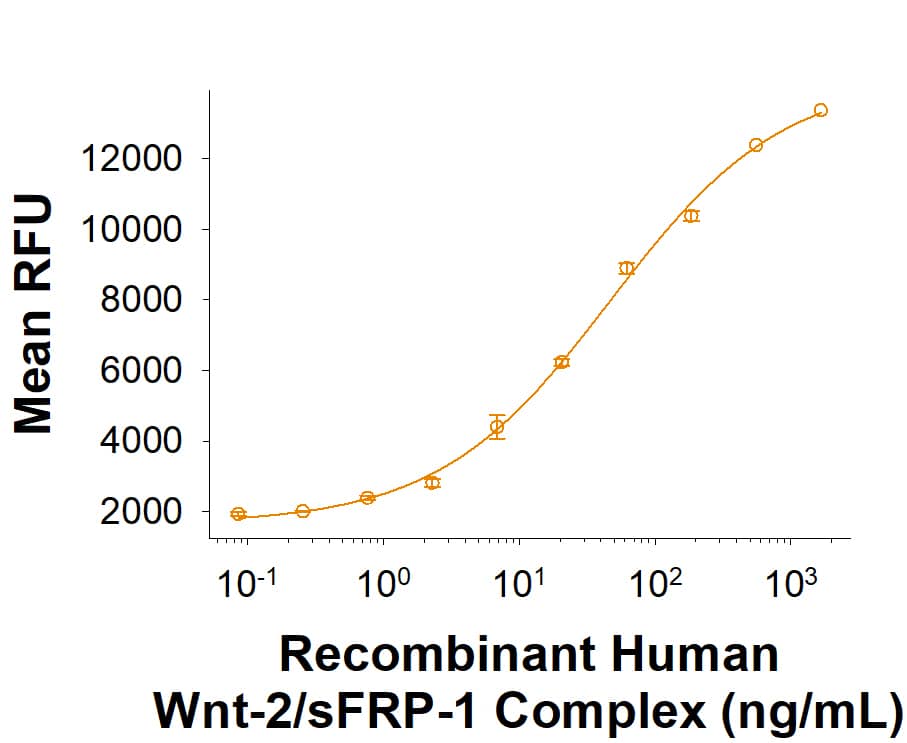Recombinant Human Wnt-2/sFRP-1 Complex Protein, CF
R&D Systems, part of Bio-Techne | Catalog # 11117-WN

Key Product Details
Source
CHO
Structure / Form
Non-covalent complex
Conjugate
Unconjugated
Applications
Bioactivity
Product Specifications
Source
Chinese Hamster Ovary cell line, CHO-derived human Wnt-2 protein
| Human Wnt-2 (Ser26-Thr360) Accession # P09544.1 |
|
| Human sFRP-1 (Ser32-Lys314) Accession # AAB70793.1 |
|
| N-terminus | C-terminus |
Purity
>90%, by SDS-PAGE under reducing conditions and visualized by silver stain.
Endotoxin Level
<0.10 EU per 1 μg of the protein by the LAL method.
N-terminal Sequence Analysis
Ser26 (Wnt-2) & Ser32 (sFRP-1)
Predicted Molecular Mass
38 kDa (Wnt-2) & 33 kDa (sFRP-1)
SDS-PAGE
30-45 kDa, under reducing conditions.
Activity
Measured by its ability to activate Wnt induced TCF reporter activity in HEK293 human embryonic kidney cells.
The ED50 for this effect is 10.0-150 ng/mL.
The ED50 for this effect is 10.0-150 ng/mL.
Scientific Data Images for Recombinant Human Wnt-2/sFRP-1 Complex Protein, CF
Recombinant Human Wnt‑2/sFRP-1 Complex Bioactivity.
Recombinant Human Wnt-2/sFRP-1 (Catalog # 11117-WN) activates TCF reporter activity in HEK293 human embryonic kidney cells. The ED50 for this effect is 10.0-150 ng/mL.Formulation, Preparation and Storage
11117-WN
| Formulation | Lyophilized from a 0.2 μm filtered solution in MOPS and NaCl with Trehalose. |
| Reconstitution | Reconstitute at 100 μg/mL in PBS. |
| Shipping | The product is shipped at ambient temperature. Upon receipt, store it immediately at the temperature recommended below. |
| Stability & Storage | Use a manual defrost freezer and avoid repeated freeze-thaw cycles.
|
Background: Wnt-2
References
- Willert, K. and R. Nusse (2012) Cold Spring Harb. Perspect. Biol. 4:a007864.
- Van Ooyen, A. et al. (1985) EMBO J. 4:2905.
- Burrus, L.W. and A.P. McMahon (1995) Exp. Cell Res. 220:363.
- MacDonald, B.T. and X. He (2012) Cold Spring Harb. Perspect. Biol. 4:a007880.
- Korinek, V. et al. (1997) Science 275:1784.
- Dennis, S. et al. (1999) J. Cell Sci. 112:3815.
- Bafico, A. et al. (1999) J. Biol. Chem. 274:16180.
- Wrona, A. et al. (2021) Histochem. Cytochem. 69:711.
- Zhang, J. et al. (2021) Front. Cardiovasc. Med. 8:751720.
Long Name
Wingless-type MMTV Integration Site Family Member 2
Alternate Names
INT1L1, IRP, Wnt2
Gene Symbol
WNT2
Additional Wnt-2 Products
Product Documents for Recombinant Human Wnt-2/sFRP-1 Complex Protein, CF
Product Specific Notices for Recombinant Human Wnt-2/sFRP-1 Complex Protein, CF
For research use only
